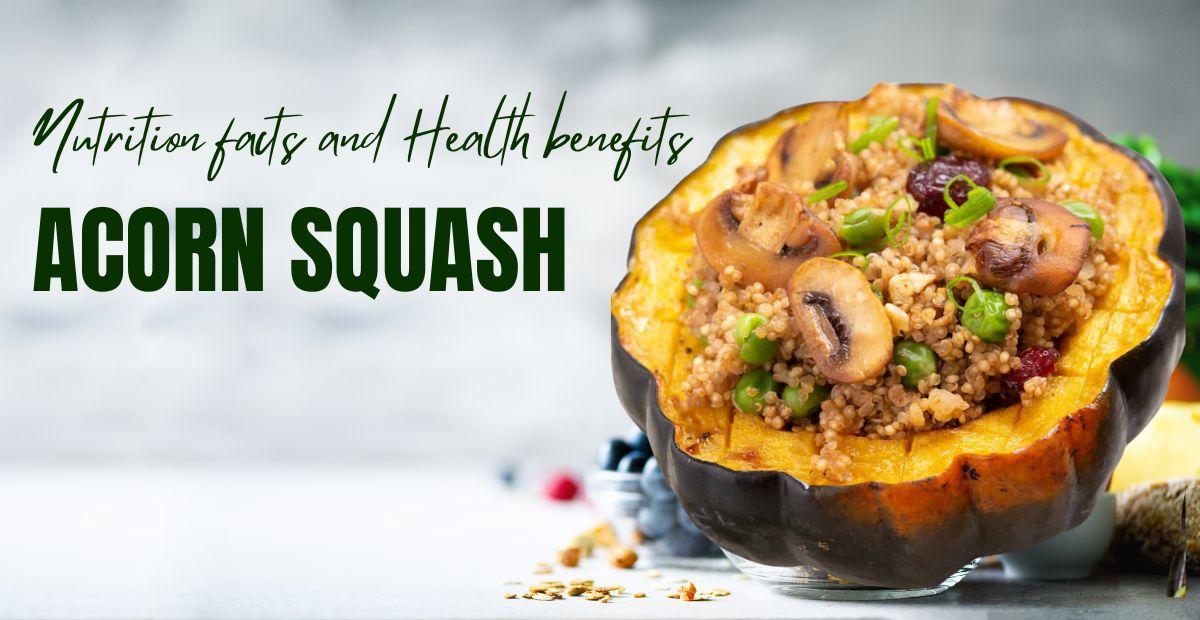Acorn squash, like pumpkin and butternut squash, is a popular winter squash cultivar in the United States. The squash is named by its shape, which consists of a disc-like flat upper end and an angled, elongated lower pavilion.
Botanically, it is a member of the Cucurbitaceae (Gourd family) of vegetables, and is closely related to pumpkin, delicata, butternut squash, hubbard, spaghetti, Japanese kuri hokkaido, calabaza, and other winter squash types.
C. pepo var. turbinata is the scientific name for this species.
For proper growth, acorn prefers well-drained, organic, sandy soils. A fully formed acorn is typically 4 inches broad, 7 inches long, and weighs 400 to 700 grammes.
It has ridges running lengthwise on its outer deep green skin. Acorn squash, like other winter squash varieties, has hard, rough skin. Yellow flowers appear 35-40 days after planting and quickly develop into elegant, elongated fruit pods.
They occur in a variety of colours and sizes, including dark green, yellow, yellow-orange, and variegated varieties; however, the dark green variety is the most prevalent. Acorn squash, like pumpkins, has golden-yellow flesh on the inside.
Winter squash blossoms, especially acorn flowers, are popular in the kitchen and are typically used to produce a side dish.
Male blossoms are typically harvested, whereas female blossoms are left to ripen. Few farmers, on the other hand, pluck small numbers of female blossoms with intact, very little fruit (baby acorn squash) to sell in markets at a higher price. Some South-eastern countries including the Philippines appreciate acorn greens (tips and tendrils).
The Health Advantages of Acorn Squash
Acorn squash nutrition contains more calories than pumpkin and pattypans. 100 grammes of raw fruit contains 40 calories, which is nearly the same as butternuts (45 calories). It has neither saturated fats nor cholesterol. Its peel is also a significant source of fibre.Gluten is a protein molecule found in foods that causes severe food intolerance in both non-celiac (gluten sensitivity) and celiac disease patients. It is one of the better gluten-free dietary substitutes for persons who suffer from a variety of gluten-related diseases.
Fresh fruits contain less vitamin A than pumpkin and supply roughly 367 IU per 100 g. Vitamin A is necessary for cell growth and development, as well as for clear vision.
Unlike pumpkin and butternut squash, acorn squash has only a little amount of flavonoid polyphenolic antioxidants such carotenes, lutein, and zeaxanthin.
Pigment compounds, in conjunction with vitamin A, aid in the removal of damaging oxygen-derived free radicals and reactive oxygen species (ROS) from the body, which have a role in ageing and disease processes.Fresh acorn contains higher vitamin C (18% RDA /100 g), pyridoxine, and thiamin than pumpkin. Vitamin C is required for collagen formation in bones, cartilage, and blood vessels, as well as for iron absorption.
It contains 17 g of folates, or 4% of the RDA, per 100 gm. Folate is required for cell division and DNA synthesis. It may help prevent neural-tube abnormalities in newborns if taken appropriately during early pregnancy.
Acorn fruit, like other winter squash cultivars, has low salt (1 mg/100 g) but plenty of potassium (347 mg/100 g), a vital intracellular electrolyte. Potassium is a heart-friendly electrolyte that helps reduce blood pressure and heart rate by counteracting the pressurising sodium effects.Acorn squash also contains trace amounts of additional B-complex vitamins including pantothenic acid and riboflavin, as well as minerals like calcium, iron, manganese, phosphorus, and zinc.
Storage and selection
Acorn squash is available in markets all year. Purchase medium-sized fresh fruits with undamaged stems. Damage, cuts and punctures, stains, bruises, and so on should be avoided.
Cured acorn squash can be stored in a cold, dry place at home for up to 3 months, just like other winter squash like butternut and pumpkin.
However, cut parts should be used right away. Alternatively, for extended usage (up to 2-3 days), put within a plastic wrap in the refrigerator set at high relative humidity.
Methods of preparation and serving
Wash fruits in cold water at home to remove any surface sand and grime. Remove the stem end. As a member of the winter squash family, the acorn has tough skin that should be peeled gently with a knife.
If you want to utilise the fruit in cooking, cut it into small cubes, wedges, or just halves. It is popular in a variety of recipes, including mashed, pureed, stuffed, grilled, and roasted potatoes.
Acorn blooms, baby fruits, and young sensitive stems and tendrils, like other squash, are delicious. Male blooms are typically harvested for use in fritters, stuffing, and other dishes. To begin, open the blooms and carefully inspect them for insects. Remove any calyces that are firmly adhered at the root.
Here are some serving suggestions:
Acorn squash can be used to vegetable salads in fresh, soft, thin slices.
The squash blossoms were dipped in chickpea flour batter, fried in oil, and served as tasty treats.
It, like pumpkin, can be used in pies, casseroles, cakes and pudding.
Acorn squash pureed with onion, carrot, and garlic to make a delectable soup.
The fruit was split in half, the seeds were emptied out, and it was baked with cheese, mushrooms, and herbs.
Acorn squash kernels are edible as a snack. Simply toast the seeds in the oven before serving.Profile of safety
Acorn squash allergies are uncommon. It is safe for pregnant women and kids

